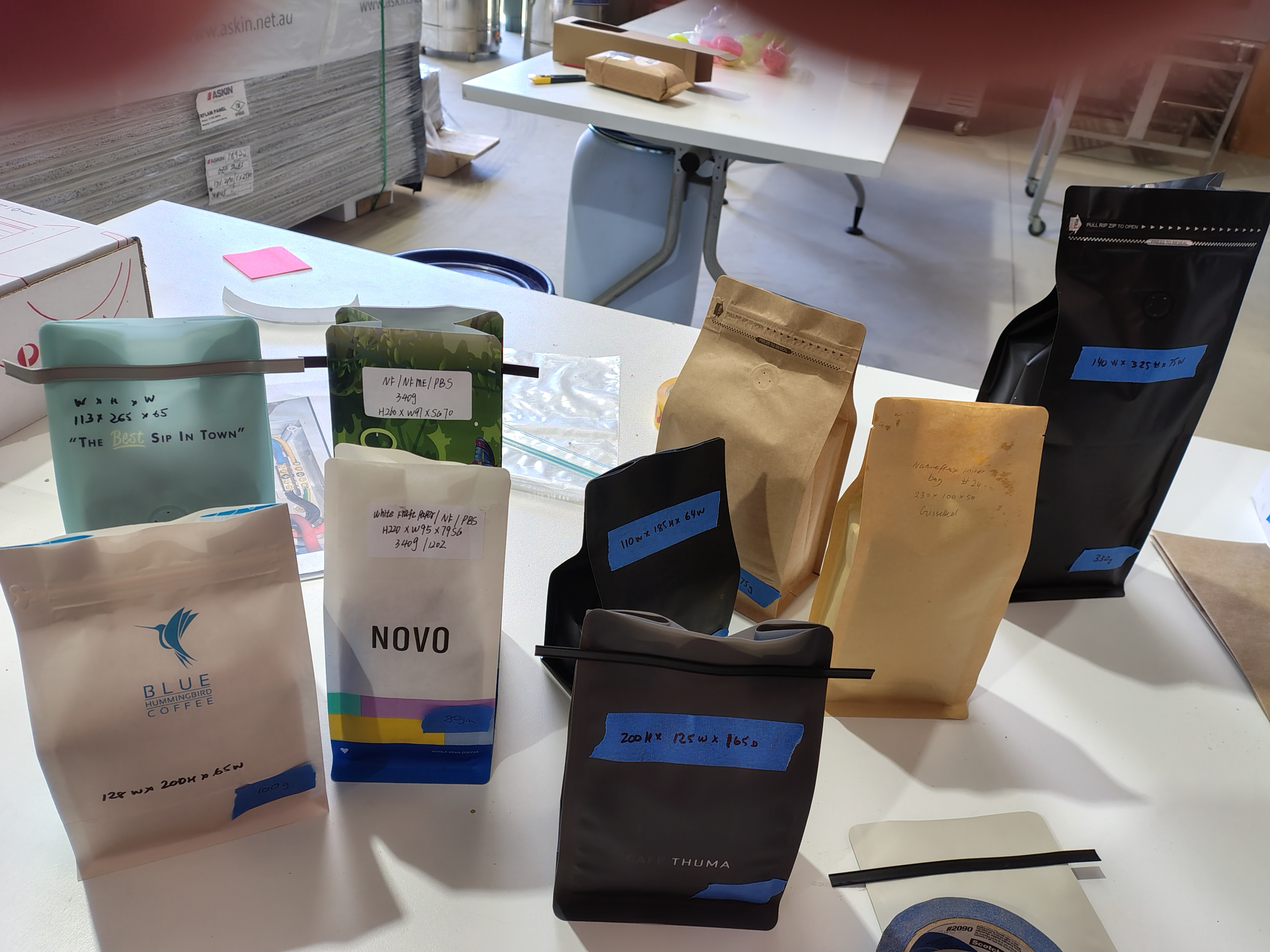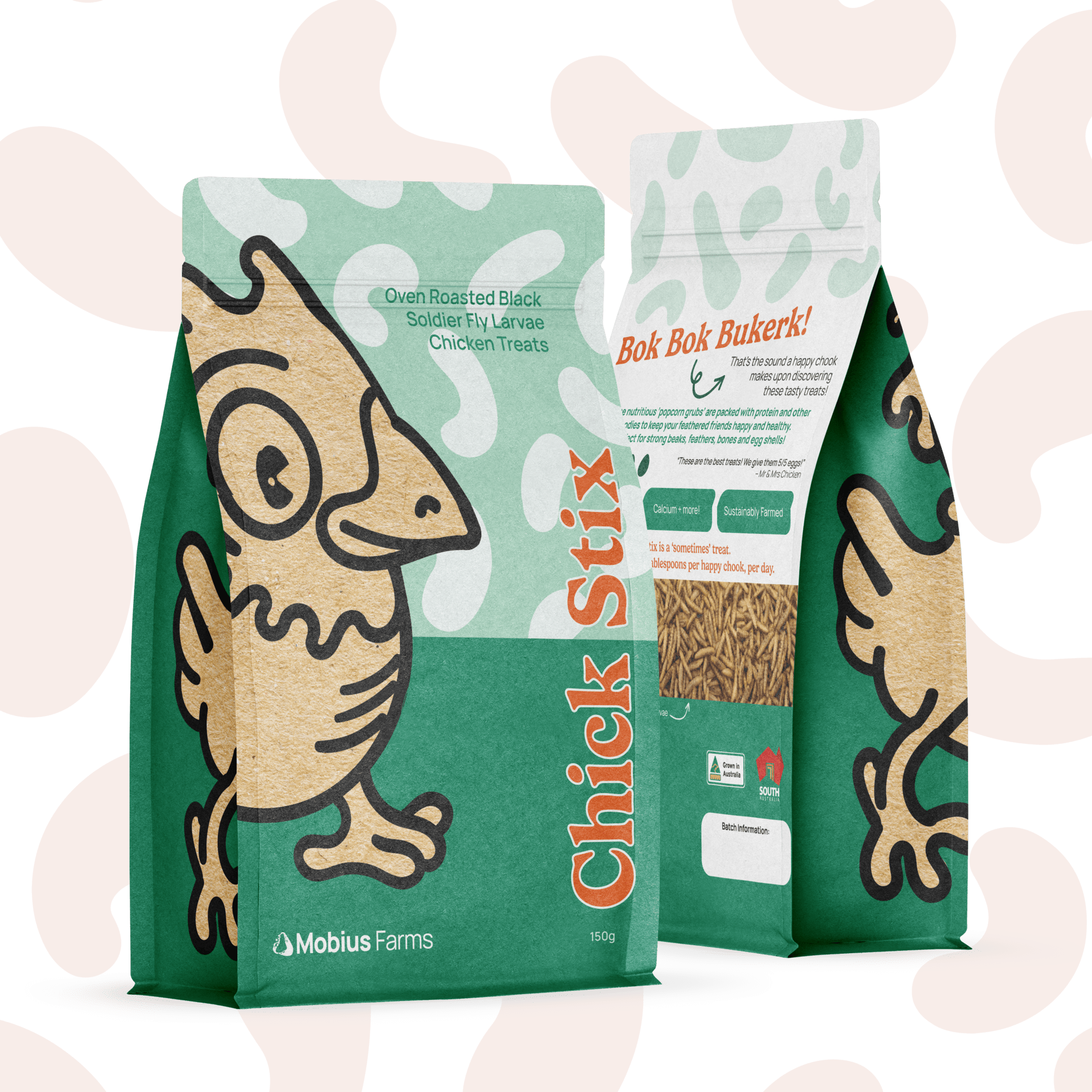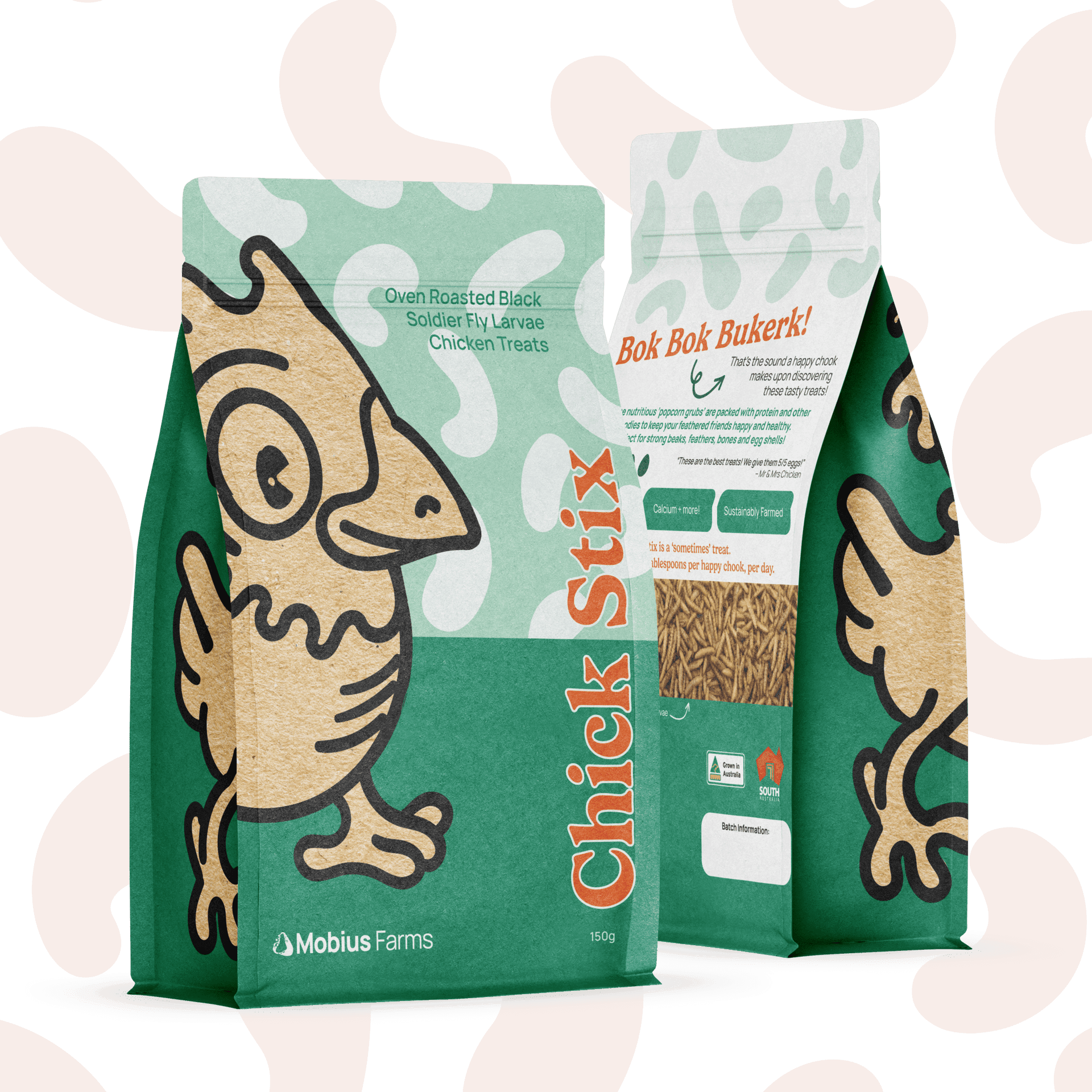
When we launched our "Chick Stix" product in 2020, we knew that our packaging choices needed to reflect the values of our business; sustainability and kindness on the planet. Hence, we embarked on a journey to identify products that would suit our needs.
What was I looking for? Minimum requirements included a resealable bag that was commercially compostable. Ideally, I wanted a transparent "window" to showcase our product and due to the fatty acid content of our oven roasted black soldier fly larvae, the bag material needed to be greaseproof.
In Australia, there are limited options for sustainable packaging, particularly if you have a limited budget. DetPak is a company supplying environmentally friendly packaging products to a broad range of industries. The “I am eco™” kraft paper, tin-tie bag is a popular choice for many dry food products including biscuits, coffee and pasta. The bag is commercially compostable and has a Polylactic Acid (PLA) lining. These are available in low Minimum Order Quantities (MOQs) which is also an important consideration for early-stage businesses.
Coupled with self-printed labels, the “I am eco™” bags are an economical option for packaging of a range of consumable products. Purchasing a sample bag will enable you to test your product fill volumes prior to designing your packaging labels.
We used these bags successfully for a few years to promote and sell Chick Stix. Customers loved the visual appeal claiming that the kraft paper gave it an "organic" feel to the product. They liked seeing the product and that the bag was resealable and compostable. Drawbacks we discovered over time included the fact that the PLA liner does weaken, particularly if exposed to high temperatures and/or humidities. There is also the risk of damage to the kraft paper bag through poor storage, transport or exposure to adverse weather conditions (like extremely wet, wintry outdoor markets!!)
Whilst this was a satisfactory product presentation for many customers, it had its limitations. Medium to larger retailers/distributors saw the product as "home-made" or "cottage" in its makeup. There is an expectation that packaging be of a certain quality standard in terms of material and presentation for mainstream sales and marketing channels. This is indisputable. We all want to buy products that are not only visually appealing, but also ensure the product itself is stored safely and protected from the elements.
As part of our business development strategy, Mobius Farms commenced the process of redesigning the packaging for Chick Stix. As the beach-head product, the packaging design choices would influence subsequent products to follow in the product portfolio. Each decision in the process needed to be carefully considered.
We maintained our core values of "environmentally friendly" packaging which for us meant eliminating soft plastics as a construction material. Whilst there is potential for soft plastics recycling in some parts of Australia, the majority of towns and cities struggle with the mountains of soft plastics generated as waste each year. We just didn't want to be a contributor to this growing problem.
Compared to a few years prior, the selection of "compostable packaging" options has grown. A quick internet search will flood your social media algorithms with a range of producers touting their products. Admittedly, compostable packaging is still very much an imperfect option. Whether it be the materials of construction, the printing inks, labels or adhesives, there are multiple elements that contribute to the integrity of "eco-friendly" product claims.
After much searching, I selected a high-profile packaging supplier that claimed to be able to supply custom printed, resealable, box bottom bags that were commercially compostable. The company website had an impressive gallery of successful packaging projects for a range of FMCG (Fast Moving Consumable Goods) brands. It looked like a great option and despite the high MOQs, I bit the bullet and put down a deposit. I was super excited until….

I asked for confirmation of the compostability of the materials of construction. Their website cheerfully stated that their bags were “compostable” and included very general information about compostable packaging. However, there was no proof or evidence, that their supply chain had certification for any of their materials for the bags I had selected. I asked the customer service officer who asked the production manager. I enquired via their social media and linked in profiles asking for the same information. After a period of radio silence, I was sent a compostability certificate that had expired the year prior!! I was shocked and disappointed that a high-profile company could make sustainability such a core part of their brand communications and yet fail to deliver on providing tangible evidence. Needless to say, I cancelled my order and requested a full refund of my deposit. Back to the drawing board.
In parallel, we were working on the brand identity for Mobius Farms" products to ensure we captured the spirit of the brand whilst providing a distinctive purchasing experience with prospective consumers. I"ll cover this in a separate blog post.
After much stress and consternation, we were able to identify a packaging supplier who was able to offer very low MOQs AND certification of the material compostability and Forestry Stewardship Council accreditation. We were back on track but running hard up against the end of year deadlines to submit the graphic design for production.
Yes, we did pay a lot more for a commercially compostable packaging option and, yes we did pay a lot more for low MOQs, but both of these decisions were made based on our values and financial circumstances. Also, being my first foray into packaging design, I thought it best to make my mistakes on a smaller batch run than a much larger one!!
My vision for the packaging design and brand identity revolved around the fabulous illustrations designed by local Adelaide artist, Wendy Dixon-Whiley and the brand design guidelines created by SourceUp for our website. Another talented South Australian, freelance graphic designer Nicole Jesenko came to the rescue and was able to pull together all the threads of our brand identity to create the gorgeous packaging artwork.
Order is in the system. Deposit has been transferred. We met the deadline and now we wait.
An email arrives in my inbox. The bags have arrived!! I nervously wait for their delivery. Had I got everything right? Would they live up to my expectations? Would our customers like them? My heart was racing as I opened the first box. They were great!

The quality was exceptional and I was really impressed with the artwork's presence. But there were still a few more tests to pass. The first test was to fill the bags with our product, and the second test was to try out the heat sealer to seal the bags without affecting the bags themselves. Compostable materials can be more heat sensitive and requires trial-and-error to get the optimum heat setting.
I tentatively filled the first bag with Chick Stix. The artwork on the front of the bag declared that there should be 100g of Chick Stix in the small bag, and 300g of Chick Stix in the larger bag. I put the small bag on the scales. “48 grams”. I tried opening the bag wider and tapping the bag to shake down the contents. I added more Chick Stix. “54 grams”. Oh no. There was just no way I could get any more product in the bag without crushing the product. The same thing happened when I tried filling the larger bag. “155 grams”. Half of what was written on the front of the bag. Where did I go wrong?!
I had based the new packaging dimensions on the dimensions of our original Detpak bags so what was different? I'd failed to take into account two key properties of the new bags: though box bottom, the bags tapered to the top meaning there was a loss of volume despite the dimensions being similar to the Detpak bags. Also, the seam allowance of the new bags i.e. where the side panels are joined to the front and back panels. These seams help strengthen the bag but reduce the available volume of the bag. Whoops!
I allowed myself to grieve for a few minutes and then worked on "the fix". I decided that I could over-sticker the incorrect pack weights. Easy. I also decided that the smaller pack sizes (than originally proposed) was not a disaster. Reworking the costings and pricings I rationalised that the smaller packs were a better value proposition for our current, and future customers. With the cost-of-living pressures, it is not a bad business decision to offer a more affordable pricing structure. There's always a silver lining!!
Our packaging supplier was so pleased with the outcome that they showcased our bags at a packaging expo in Melbourne. We soft launched the new packaging at the Clare Autumn Garden Festival and it was received with praise from existing and new customers! It was not always smooth sailing, but I learned a lot from the process and hope that by sharing my experience, it might help others undertaking a similar project.
